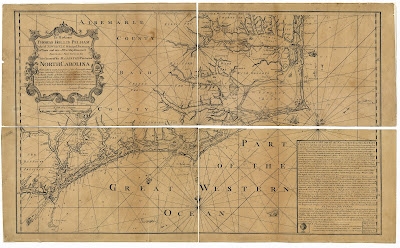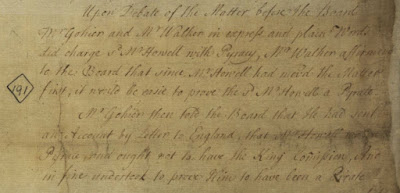In fishing about the Bahamas shipping records 1721-1725 - did you catch the pun, there? - I came across some familiar names of characters in Virginia, North Carolina, or Bahamian pirate history.
Of course, the Bahamas are just across the Florida Channel from the Carolinas. It's not far away. And, the Lords Proprietors in England owned both properties by 1671, so... anyway, anyone familiar with pirate history should recognize these names.
There's John Vickers, formerly of York River, Virginia, now sailing from Carolina in John Lovick's 22/29-ton sloop Carolina Adventure. Vicker's made a famous deposition concerning pirates Benjamin Hornigold and Henry Jennings at the Bahamas. Lovick was a commissioner, secretary, later vice-admiralty court judge, and naval collector in Carolina; he also was the first Englishman granted Ocracoke Island, where Edward "Blackbeard" Thache was killed in 1718. Small world, right? It actually was in the early 18th century.
| John Vickers in 22/29-ton sloop Carolina Adventure |
There's also three former pirates who had surrendered to Capt. Vincent Pearse of HMS Phoenix in 1718.
One, John Cockram, sometimes with his brother Joseph Cockram, mastered the jointly-owned 30-ton sloop of New Providence Richard & John, not surprisingly owned with Richard Thompson, a trader so infamous as a pirate loot dealer or fence that he was represented on Stars! series Black Sails as Richard Guthrie:
 |
| Sean Cameron Michael is a South African actor best known for his role as pirate-fence Richard Guthrie |
John Cockram, of course, was the real-life pirate doctor aboard Bermudan-transplant of Kingston Henry Jennings' sloop Barsheba. Jennings was the nut crazy enough to raid Spanish La Florida to steal their gold & silver salvaged from 11 Spanish vessels wrecked in the hurricane of July 30, 1715. Jennings also stole a French prize originally taken by Benjamin Hornigold from Bahia Honda, Cuba! Mentioned earlier, John Vicker's deposition talked about this.
| John Cockram, master of 30-ton sloop of New Providence Richard & John |
But, before Jennings, Cockram sailed with Hornigold in 1714 to steal Spanish goods off Cuba! Newpapers said "said Cockrum fitted out of Providence with 20 Men upon the Coast of Florida" to steal 2,000 pieces of eight from the Spanish.
The records in CO 27/12, Bahamian Shipping Lists, 1721-1725 also show former pirate Daniel Stillwell as master of his own 5-ton sloop Happy Return, formerly owned by his father in law.
| Daniel Stillwell as master of his own 5-ton sloop Happy Return |
Hailing from Jamaica, Stillwell married the daughter of Jonathan Darvill before settling on Eleuthera. Borrowing Darvill’s shallop, he and a small crew (including Darvill’s son) captured a Spanish ship off of Cuba which carried over 11,000 pieces of eight around 1714.
Deputy Governor Thomas Walker of Nassau heard about the attack and as Spain and England had recently concluded a peace treaty, had Stillwell and his crew seized. Lacking authority to try Stillwell locally, he had Stillwell sent to Jamaica for trial. Hornigold had been using Darvill’s sloop Happy Return for his own piracy (and some sources indicate Hornigold had been with Stillwell off of Cuba), and had declared that all the Bahamas pirates were under his protection. He intercepted the ship carrying Stillwell and freed him, returning to Nassau to threaten Walker for interfering.
Incidentally, Thomas Walker and his sons are in these shipping records as well. The Walkers owned and operated the 15-ton New Providence-built sloop Industry. Neal Walker mastered the 20-gun Dover of New Providence. Charles Walker mastered the 10-gun Two Brothers of New Providence.
| Thomas Walker operated the 15-ton New Providence-built sloop Industry |
Stillwell later sailed as a crewmember aboard Hornigold’s ship. When King George offered a general pardon to all pirates who surrendered before September 1718, Stillwell accepted. He later became a ship owner, purchasing several vessels that operated out of the islands, including his father-in-law Jonathan Darvill’s old Happy Return. He sailed to Jamaica with Braziletto wood to trade for 100s of gallons of Rum to fuel Nassau's many taverns.
Thomas Terrill also appears as master and owner of 12-ton condemned Spanish sloop Endeavor, which probably carries an interesting story of its own, seeing as how the Bahamas had been raided a couple of times by the Spanish.
 |
| Thomas Terrill as master and owner of 12-ton condemned Spanish sloop Endeavor |
Two very interesting ship masters hold great meaning for North Carolina's history. One, for 29 June 1721 was for 50-ton sloop Diamond of London, master Matthew "Higgingbotham." Diamond's owner was Samuel Buck, one of several merchants who negotiated with the Lords Proprietors of Carolina and the Bahamas for a 7-year lease of the Bahamas, beginning in 1717. James Gohier was another one who appears as shipowner in these records.
 |
| Matthew "Higgingbotham" of 50-ton sloop Diamond of London |
An interesting note on the cargo in Diamond states "European goods as p[er] cocquete." Now, Merriam-Webster's Definition of coquette shows:
1: a woman who endeavors without sincere affection to gain the attention and admiration of men
2: any of several small, tropical American hummingbirds (genus Lophornis) with the males typically having a colorful or ornate tuft of feathers on the head
The first definition would ironically be appropriate, considering the notorious reputation of Nassau with ladies of the night! Still, I hardly think that the women would be listed as "cargo." The 2nd definition of the exotic birds... well, that, too is doubtful. But, birds can be found there, sure.
No, there's another explanation:
 |
| 19th cent. "cocquet" or order certificate |
These "European goods" probably were men's powdered wigs, or ladies' fancy corsettes and ordered like on Amazon. Diamond simply delivered the order like an 18th century UPS, "p[er] cocquete."
Another name on these shipping records important to North Carolina is master James Wimble of 5-ton sloop Hardtimes, built in South Carolina and later master of Bermudan-built 5 -ton Bonetta. Wimble had been born in Hastings, Sussex, England and came to the Bahamas when it became free of pirates in 1718.
This man was essentially the prime motivator in the development of the town of Wilmington in North Carolina's Lower Cape Fear. Several mariners had been involved in conceiving the town, including this same surveyor and mapmaker Capt. Matthew Higginbotham, who lived for a while in Brunswick Town, across the Cape Fear River from New Town, Newton, New Liverpoole, New Carthage, or as it was finally known in 1740, Wilmington.
 |
| 1733 James Wimble Map of Wilmington area |
 |
| 1738 James Wimble Map of North Carolina |
























